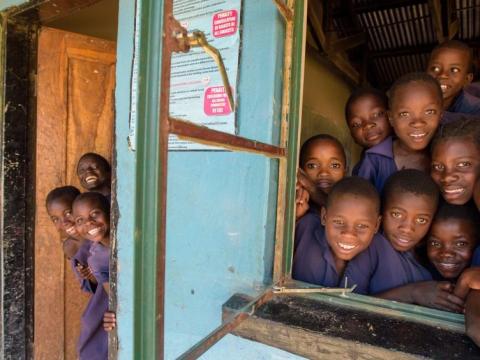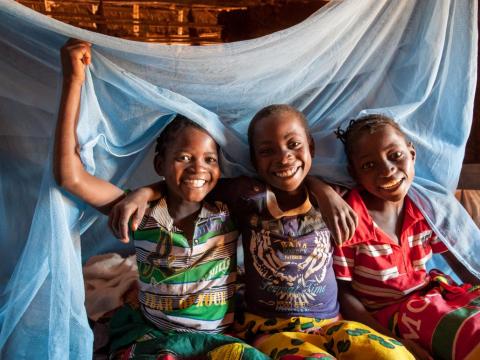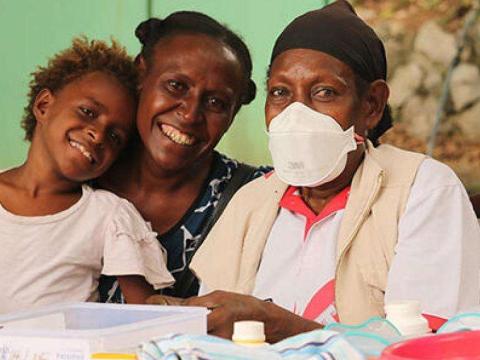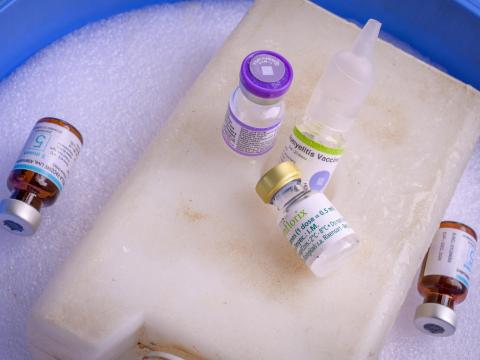Infectious Diseases
In low- and middle-income countries, children are significantly more vulnerable to infectious diseases and are 18 times more likely to die from them compared to children in high-income countries (UNICEF). Many of these diseases – including polio, measles, diphtheria, tetanus, and pertussis – are preventable through early vaccination. Others, such as malaria, tuberculosis, and HIV/AIDS, remain persistent challenges. Reducing their spread through community-based strategies and the provision of essential health commodities is a key focus of World Vision's health work.
Through its integrated approach across health facilities, communities, and households, World Vision aims to reduce illness and death caused by infectious diseases. Strengthening community health worker programmes and supporting immunisation efforts are central to this work. Collaboration with governments, Ministries of Health, faith and community leaders, and donors ensures that these efforts are far-reaching, sustainable, and impactful.
Disease Programming
Through the financial support of the Global Fund and other partners, World Vision tackles the prevention and treatment of the following infectious diseases.
Additional Work in Infectious Diseases
Polio
Since 1999, World Vision has partnered in the CORE Group Partners Project (CGPP) – a multi-country, multi-partner initiative aimed at eradicating polio. TThe CGPP supports organisations through financial assistance and technical guidance to improve vaccine uptake, conduct disease surveillance, and strengthen health systems. In addition to targeting polio, the project also addresses other vaccine-preventable diseases such as measles.
World Vision has contributed to these efforts in Angola, Bangladesh, Ethiopia, India, Kenya, and South Sudan.
CORE Polio is a testament to civil society's role in public health, and collective action. It is amazing really that the world does not do better to celebrate seminal achievements like the elimination of polio. It is the kind of story that gives us hope for a better future.
- Dan Irvine, Global Director, Health and Nutrition, World Vision International

For more on World Vision’s work to end polio, read Akujo Mary's story – an inspiring account of resilience and the pursuit of dreams in the face of disability.
Mpox
Between 2022 and 2024, mpox (formerly known as monkeypox) has seen a sharp rise in cases globally, including in countries not previously considered endemic. The virus has now been reported in 116 countries, signalling its growing potential for global transmission. Unlike previous outbreaks, the current situation has shown sustained human-to-human transmission, primarily through close physical contact within households and communities.
On 14 August 2024, the World Health Organization declared mpox a public health emergency of international concern, citing its disproportionate impact on vulnerable populations – especially children, immunocompromised individuals, and people in humanitarian settings.
Children in low- and middle-income countries, particularly in fragile and crisis-affected contexts, face heightened risks due to overcrowding, poor healthcare infrastructure, malnutrition, and limited access to clean water and sanitation. These conditions increase both their exposure to the virus and the likelihood of severe outcomes.
Learn more about World Vision's emergency mpox response and how we are working to protect the most vulnerable.
"Preventing further spread is not just solidarity, but an investment in global health security," says Dan Irvine, Global Director, Health and Nutrition. He highlights the EU’s critical role against mpox, from vaccines to building further resilience in African health systems. Read his op ed in the EU Observer.
Ebola
The 2014–2016 Ebola outbreak in West Africa was the largest and most complex since the virus was first identified in 1976 (WHO). Subsequent outbreaks have continued to pose serious public health challenges, including the second-largest outbreak in history, which occurred in the Democratic Republic of the Congo (DRC) between 2018 and 2021.
World Vision continues to support communities that have survived past Ebola crises, as well as those currently facing new outbreaks. During the epidemic in Sierra Leone, World Vision’s health emergency response team reached 1.6 million people with lifesaving support.
In collaboration with its Channels of Hope team, World Vision worked closely with community health workers and faith leaders to raise awareness about the disease, reduce stigma, and promote behaviours that helped prevent further fatalities. This faith-based approach remains central to ongoing efforts, as World Vision continues to bring hope and support to families and communities affected by Ebola. Read more here.
World Vision also played a key role in advancing vaccine readiness as part of the Ebola Vaccine Deployment, Acceptance, and Compliance (EBODAC) consortium. From 2014 to 2021, the consortium operated in the DRC, Rwanda, Sierra Leone, and Uganda to promote the acceptance and uptake of new Ebola vaccines. Through mobile messaging, clear community communication, and trust-building initiatives, EBODAC tackled vaccine hesitancy and strengthened local health systems. Working alongside ministries of health and community health workers, the project built local capacity and developed tools to support future vaccine deployment efforts.
COVID-19
On 11 March 2020, the World Health Organization declared COVID-19 a global pandemic. Within hours, World Vision launched one of the largest emergency responses in its history, spanning more than 70 countries. The response prioritised children and families in the most vulnerable and fragile contexts – conflict-affected areas, urban slums, and refugee settings – where the risks to children were greatest.
World Vision’s global COVID-19 response exceeded its target, reaching over 72 million people, including 36 million children.
The response focused on four strategic objectives:
- Scaling up preventative measures to limit the spread of the virus
- Strengthening health systems and frontline health workers, including the training and support of community health workers
- Supporting children affected by COVID-19 through interventions in education, child protection, food security, and livelihoods
- Collaborating and advocating to ensure the protection of vulnerable children
World Vision continues to build on the lessons and partnerships formed during the pandemic to strengthen preparedness and response to future global health emergencies. Learn more about World Vision's COVID-19 emergency response.
Zika
First detected in Brazil in May 2015, the Zika virus – transmitted by the Aedes aegypti mosquito – quickly became a global health concern. A major risk associated with Zika is its link to microcephaly, a congenital condition in which babies born to infected mothers may experience incomplete brain development.

In response, World Vision worked in affected countries to deliver essential services and resources aimed at preventing transmission. Efforts included the distribution of mosquito nets, insect repellents, and protection kits for pregnant women, as well as the provision of health services for those infected.
Within six months, World Vision reached more than three million people across over 1,000 communities in the most severely affected areas. The response focused on:
- Promoting individual protection behaviours and vector control
- Engaging communities in sanitation campaigns
- Supporting pregnant women with targeted resources and information
To strengthen the broader response, World Vision also supported ministries of health and the global health community by collecting and sharing epidemiological data to improve prevention and control efforts.
Learn how community volunteers and smartphones helped to reveal dangerous gaps by surveying over 3,000 people in 6 countries.




